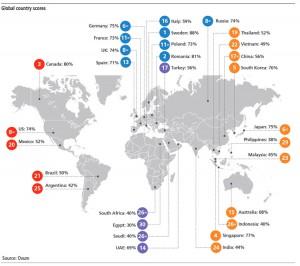Ovum just published a 35 page detailed study,(pdf) entitled the ” the Global Broadband Experience Scorecard” which analyzed fixed line broadband use by consumers in the top 30 countries

Sweden scored the highest level of broadband experience (with a score of 88%) of the 30 countries researched.
The United States has a Score of 8 well below its neighbor to the north, Canada which had a score of 3.
India was ranked 24th among 30 countries with a score of 44%.
Egypt is ranked 30th with a score of 30%.
Here are the top 8 key findings in the report:
1. There are significant gaps in current customer experience. 30% of customers churned in the last 12 months due to the for faster speed and better customer service.
2. 10Mbps is the new minimum for quality broadband services.
3. Customers in mature markets rate their network performance 10% worse than it actually is.
4. More than half of consumers are dissatisfied if the network response time is longer than 3 seconds. Zero response
(waiting) time is the customer’s desirable experience.
5. 33% of customers claim that their broadband service didn’t meet their expectations based on the service they signed up
for.
6. The Best Network Experience is based on three core elements:
Network performance: A stable and reliable network, waiting time (zero to maximum 3 secs), buffering (never to rare) and picture quality (excellent rating)
Network speed: Minimum 10Mbps for Internet applications and SD video, 50Mbps+ for UHD/HD video
Excellent customer service: Issue resolution at first contact, responsive service provisioning, activation and restoration
7. Video becomes the basic service. Nearly 80% and 50% of customers watch short and long videos frequently among the common applications.
8. Video experience is not performing well in most (80%) of the surveyed countries.
9. Customers use average of four (4) devices in the household in mature markets
